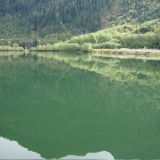When I’ve finished you will see why I call the Gordon (Pinocchio)
Campbell government gigantic fibbers – to avoid the more appropriate “L”
word.
Let’s go back to what Finance Minister Colin Hansen had to say about
private energy projects and if you “Google” “Colin Hansen power” you
will see and hear for yourself. It is a tissue of fibs.
1. He says BC is a net importer of power. That’s a falsehood. BC Hydro
is a net importer some years but BC as a province is a net exporter,
That can be proved by looking at the figures from the National Energy
Board which monitors exports. Moreover, when BC Hydro imports from
Alberta it does so at “off peak” hours thus very cheaply and because
Hydro can “store” energy as water in their reservoirs, it exports that
power below the line during “peak” periods making a very tidy profit. To
think that our Finance Minister doesn’t know that, explains a lot about
financial affairs he and the premier have grossly mismanaged and told
fibs about. Hanson says that independent power producers are small
outfits and that the rivers continue at “their normal stream”. This,
again, is an outrageous falsehood! Look at our website at
www.thecanadian.org or www.saveourrivers.ca and see the visual evidence
for yourself through Damien Gillis’s videos.
2. Hansen says that only .03% of rivers will be used. The actual
figure is double that but the important fact for British Columbians is
that at least 600 rivers are targeted all of which have substantial fish
values and the power plants will kill the ecology these rivers sustain.
He neglects to mention the very substantial clear cutting required for
roads and transmission lines.
3. Hansen says these projects are widely supported by many
environmentalists. I can think of three – Tzeporah Berman who is seen by
most environmentalists as a turncoat for her own profit, Dr. Marc Jaccard
who is in the pay of the BC government and Dr. David Suzuki who only
supported it if rivers were safe and, as I understand it – David can
speak for himself, of course – he has serious reservations about the
Energy Policy as being implemented.
4. Hansen says that these projects are “clean and green”. It is safe
to say that when you see the words “clean and green” the very opposite
is true and that very much applies to the bunch who call themselves
“Citizens for Green Power”, an organization which shills for the private
power producers.
See the video yourself – the only true statement is the minister’s
name.
Also remember that Pinocchio himself and the three who have been Energy
Minister over the past several years have maintained that this private
power is to give BC energy sufficiency by 2016.
Let me now tell you the real story.
I have spoken around the province, written in articles and stated on
radio and TV the following:
1. BC is not in need of energy and won’t be for a very long time to
come if we practice conservation, (a word foreign to us, sadly), upgrade
present facilities, put generators on flood control dams and take back
the power we’re entitled to under the Columbia River treatment.
2. BC Hydro is forced by the government to enter contracts with
private producers to buy power, on a take or pay basis, at double or
more what they can sell it for on the export market.
3. I have said that this private power must be sold by BC Hydro
because it can only be produced during the annual run-off thus is not
available to BC Hydro in the colder months when Hydro can use it. Don
McInnes, Head of Plutonic Energy, partnered with General Electric,
stated that you would “have to have been on Mars not to know that this
energy was for export”.
4. I’ve stated that because BC Hydro must lose huge sums a year
financing private energy producers (the contracts total about $40
BILLION at this point), it will no longer be able to pay its handsome
annual dividend to the BC Government but that they will still pay the
dividend by increasing rates to us the BC public!
What we have not heard from Pinocchio and his ministers is an admission
that this power is not for BC use as claimed, has nothing to do with
making BC self sufficient and moreover is being subsidized by the public of
BC through its crown corporation, BC Hydro.
Now, however, the truth is out, though you had to read it in the Globe
and Mail, not Canwest which is the laundry for the BC government’s dirty
linen.
On Page S3 of the Globe and Mail for July 30 there is an interview under
the headline POWER POLITICS, Will the Clean Energy Act clear the way for
British Columbia to become a significant exporter of renewable energy?
Bill Bennett, the Energy Minister, the cabinet blab, states “we are
actively working toward developing export opportunities to markets such
as California. Many states and provinces want to reduce their emissions
by replacing energy generated from carbon intensive fuels and we are in
a unique position to offer these jurisdictions clean and reliable power
generated at competitive prices. (I’ll say!! RM) We will need to work
with independent power producers as we seek and advance these
opportunities.”
“BC Hydro, as required under this act (the so-called Clean Energy Act –
RM) will present to government an integrated resource plan on export
opportunities. In the meantime, the government is committed to working
collaboratively with the independent power industry.”
To digress for a moment, you are probably asking yourself, as I have
asked, if this is such a terrific idea, why isn’t it being done by BC
Hydro, our own company, so that all the profits would flow to the BC
Treasury?
For the purposes of this article I simply underscore the obvious – what
I’ve been saying and writing has been absolutely true – this private
power is not for BC consumption and that all the profits of this swindle
go to private companies, not to the public of British Columbia where
they belong.
We also must conclude, on the evidence of the minister responsible, that
the sobriquet “Pinocchio” is indeed fitting for Gordon Campbell, the
premier of this province who is justifiably shown by our cartoonist
Gerry Hummel with his pants on fire.




